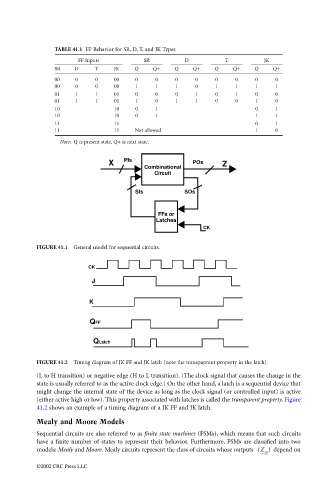Page 1111 - The Mechatronics Handbook
P. 1111
TABLE 41.1 FF Behavior for SR, D, T, and JK Types
FF Inputs SR D T JK
SR D T JK Q Q+ Q Q+ Q Q+ Q Q+
00 0 0 00 0 0 0 0 0 0 0 0
00 0 0 00 1 1 1 0 1 1 1 1
01 1 1 01 0 0 0 1 0 1 0 0
01 1 1 01 1 0 1 1 0 0 1 0
10 10 0 1 0 1
10 10 0 1 1 1
11 11 0 1
11 11 Not allowed 1 0
Note: Q is present state, Q+ is next state.
X PIs POs Z
Combinational
Circuit
SIs SOs
FFs or
Latchea
CK
FIGURE 41.1 General model for sequential circuits.
CK
J
K
QFF
QLatch
FIGURE 41.2 Timing diagram of JK FF and JK latch (note the transpaprent property in the latch).
(L to H transition) or negative edge (H to L transition). (The clock signal that causes the change in the
state is usually referred to as the active clock edge.) On the other hand, a latch is a sequential device that
might change the internal state of the device as long as the clock signal (or controlled input) is active
(either active high or low). This property associated with latches is called the transparent property. Figure
41.2 shows an example of a timing diagram of a JK FF and JK latch.
Mealy and Moore Models
Sequential circuits are also referred to as finite state machines (FSMs), which means that such circuits
have a finite number of states to represent their behavior. Furthermore, FSMs are classified into two
models: Mealy and Moore. Mealy circuits represent the class of circuits whose outputs (Z ) depend on
m
©2002 CRC Press LLC

